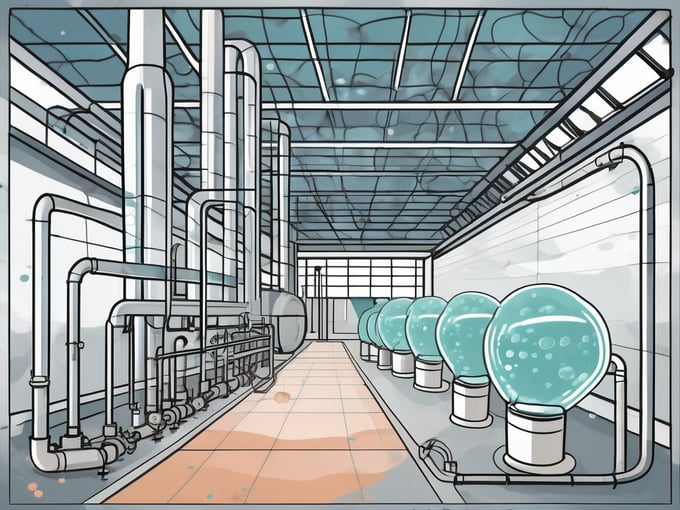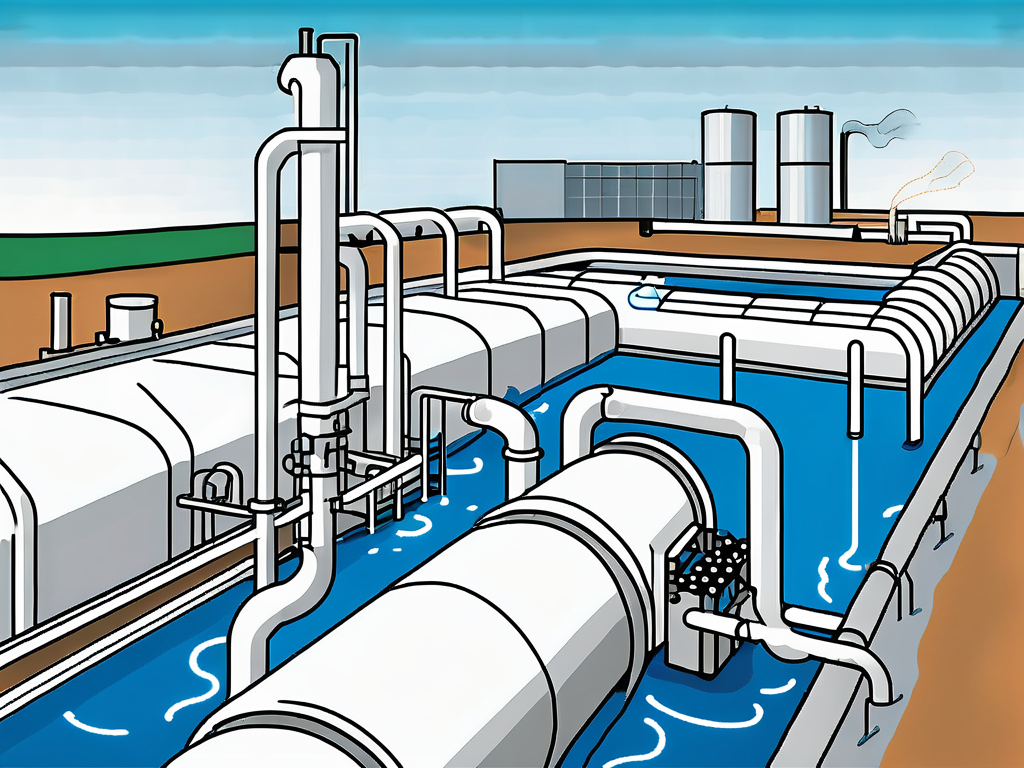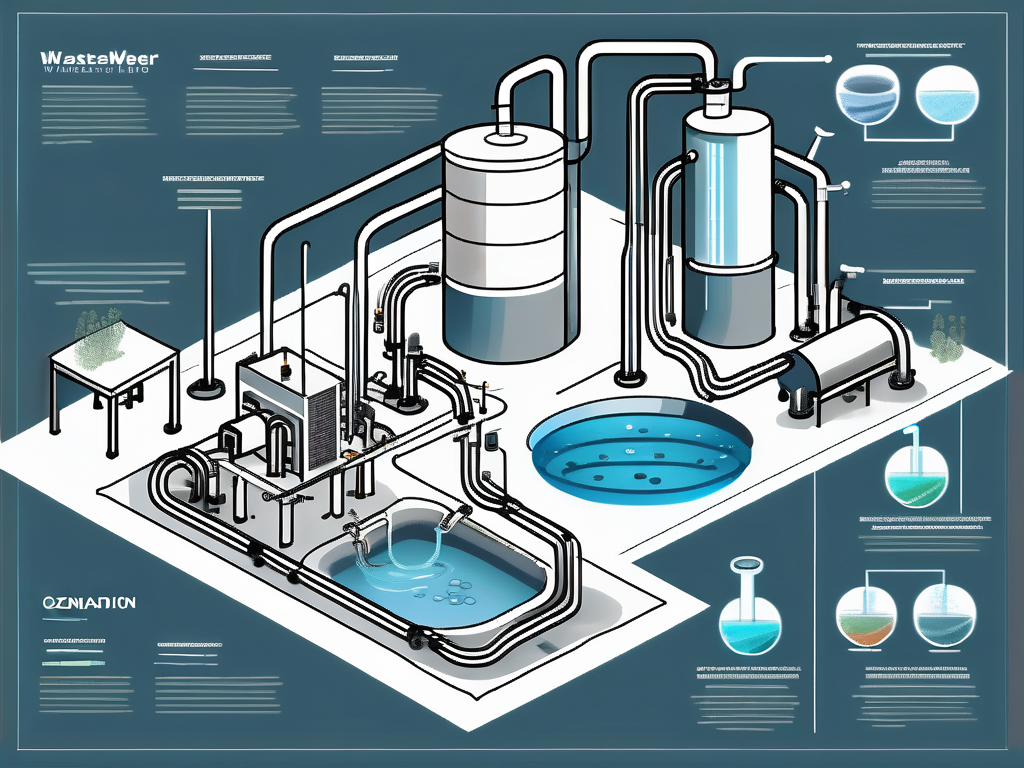
Ozonation: Wastewater Treatment Explained
Ozonation is a crucial process in the treatment of wastewater, playing a significant role in the removal of contaminants and the improvement of water quality. This process involves the use of ozone, a powerful oxidizing agent, to break down harmful substances in wastewater. The application of ozonation in wastewater treatment is a complex subject, encompassing a range of scientific principles and technical considerations.
As a wastewater treatment method, ozonation offers several advantages, including the ability to effectively remove a wide range of pollutants, the absence of harmful by-products, and the potential for water disinfection. However, the process also has its challenges, such as the need for careful control of ozone levels and the potential for equipment corrosion. This article provides a comprehensive overview of the ozonation process, its applications, benefits, and challenges in wastewater treatment.
Understanding Ozonation
Ozonation is a chemical process that involves the use of ozone (O3), a molecule composed of three oxygen atoms, to oxidize various substances. In the context of wastewater treatment, ozonation is used to oxidize organic and inorganic compounds, effectively breaking them down into less harmful substances. The process is highly effective at removing a wide range of pollutants, including bacteria, viruses, fungi, organic compounds, and heavy metals.
The ozonation process begins with the generation of ozone, typically through an electrical discharge or ultraviolet radiation. The ozone is then diffused into the wastewater, where it reacts with the pollutants. The reaction results in the breakdown of the pollutants and the formation of less harmful substances, which can be easily removed from the water.
Ozone Generation
Ozone is typically generated on-site at the wastewater treatment plant, using either an electrical discharge or ultraviolet radiation. Electrical discharge, also known as corona discharge, involves passing a high voltage through a gas that contains oxygen. The high energy breaks the oxygen molecules into individual atoms, which then combine with other oxygen molecules to form ozone.
Ultraviolet radiation, on the other hand, involves exposing oxygen to UV light at a specific wavelength. The UV light breaks the oxygen molecules into individual atoms, which then combine to form ozone. While both methods are effective at generating ozone, electrical discharge is more commonly used due to its higher efficiency and lower cost.
Ozone Diffusion
Once the ozone has been generated, it is diffused into the wastewater. This is typically done using a diffuser, which releases the ozone into the water in the form of tiny bubbles. The small size of the bubbles increases the surface area of contact between the ozone and the water, enhancing the efficiency of the oxidation process.
The diffusion process is critical to the effectiveness of ozonation. If the ozone is not properly diffused, it may not come into contact with all of the pollutants, reducing the effectiveness of the treatment. Therefore, the design and operation of the diffuser are crucial factors in the success of the ozonation process.
Applications of Ozonation in Wastewater Treatment
Ozonation is used in wastewater treatment for several purposes, including the removal of organic and inorganic pollutants, disinfection, and the improvement of water quality. The process is particularly effective at removing pollutants that are difficult to remove using other methods, such as certain organic compounds and heavy metals.

In addition to its effectiveness at removing pollutants, ozonation also has the advantage of not producing harmful by-products. Unlike other treatment methods, which can produce sludge or other waste products, ozonation results in the formation of oxygen and other harmless substances. This makes the process environmentally friendly and reduces the need for further waste treatment.
Removal of Organic Pollutants
One of the main applications of ozonation in wastewater treatment is the removal of organic pollutants. These pollutants, which include substances such as pesticides, pharmaceuticals, and industrial chemicals, can be harmful to both humans and the environment. Ozonation is highly effective at breaking down these compounds, transforming them into less harmful substances that can be easily removed from the water.
The effectiveness of ozonation in removing organic pollutants is due to the high oxidizing power of ozone. When ozone comes into contact with an organic compound, it can break the compound's chemical bonds, leading to its degradation. The resulting substances are typically more biodegradable and less toxic than the original pollutants, making them easier to remove from the water.
Disinfection
Ozonation is also used for disinfection in wastewater treatment. The process is highly effective at killing bacteria, viruses, and other microorganisms, making it an important step in the treatment of wastewater. The disinfecting power of ozone is due to its ability to damage the cell walls and membranes of microorganisms, leading to their death.
The use of ozonation for disinfection has several advantages over other methods. Unlike chlorination, which can produce harmful by-products, ozonation does not result in the formation of disinfection by-products. Additionally, ozone is effective against a wider range of microorganisms than other disinfectants, making it a versatile tool in wastewater treatment.
Benefits and Challenges of Ozonation
Ozonation offers several benefits as a wastewater treatment method, including its effectiveness at removing a wide range of pollutants, its disinfecting power, and its environmental friendliness. However, the process also has its challenges, including the need for careful control of ozone levels and the potential for equipment corrosion.
Despite these challenges, the benefits of ozonation often outweigh its drawbacks, making it a valuable tool in wastewater treatment. With proper design and operation, the ozonation process can significantly improve the quality of treated wastewater, contributing to the protection of human health and the environment.
Benefits of Ozonation
The primary benefit of ozonation is its effectiveness at removing a wide range of pollutants from wastewater. The process is capable of breaking down both organic and inorganic compounds, making it a versatile tool in wastewater treatment. Additionally, ozonation is highly effective at disinfecting wastewater, killing a wide range of bacteria, viruses, and other microorganisms.
Another significant benefit of ozonation is its environmental friendliness. Unlike other treatment methods, ozonation does not produce harmful by-products. Instead, the process results in the formation of oxygen and other harmless substances. This reduces the environmental impact of wastewater treatment and reduces the need for further waste treatment.
Challenges of Ozonation
Despite its many benefits, ozonation also has its challenges. One of the main challenges is the need for careful control of ozone levels. Too much ozone can be harmful to both humans and the environment, while too little may not effectively remove all pollutants. Therefore, the ozone concentration must be carefully monitored and controlled to ensure the effectiveness and safety of the process.
Another challenge is the potential for equipment corrosion. Ozone is a powerful oxidizing agent, which can corrode certain materials. Therefore, the equipment used in the ozonation process must be made of materials that are resistant to ozone, such as stainless steel or certain types of plastic. This can increase the cost of the equipment and the overall cost of the treatment process.
Future of Ozonation in Wastewater Treatment
The use of ozonation in wastewater treatment is likely to increase in the future, due to its effectiveness at removing a wide range of pollutants and its environmental friendliness. As the demand for clean water continues to grow, and as the types and quantities of pollutants in wastewater continue to change, the need for effective and environmentally friendly treatment methods like ozonation will only become more important.
Research is ongoing to improve the efficiency and cost-effectiveness of the ozonation process. This includes the development of new ozone generation technologies, the optimization of ozone diffusion methods, and the exploration of ways to combine ozonation with other treatment methods to enhance its effectiveness. With these advancements, the role of ozonation in wastewater treatment is expected to continue to grow in the coming years.
Advancements in Ozone Generation
One area of ongoing research is the development of new ozone generation technologies. Current methods, such as electrical discharge and ultraviolet radiation, are effective but can be energy-intensive. Researchers are exploring alternative methods, such as plasma-based ozone generation, which could potentially be more efficient and less costly.
Another area of research is the optimization of ozone diffusion methods. The efficiency of the ozonation process depends largely on the effectiveness of the ozone diffusion, which in turn depends on the design and operation of the diffuser. Researchers are exploring ways to improve the design of diffusers and the operation of the diffusion process to enhance the efficiency of ozonation.
Combining Ozonation with Other Treatment Methods
Another promising area of research is the combination of ozonation with other treatment methods. By combining ozonation with methods such as biological treatment or advanced oxidation processes, it may be possible to enhance the removal of pollutants and improve the overall effectiveness of the treatment process.
For example, the combination of ozonation and biological treatment, known as the O3/Bio process, has been shown to be effective at removing certain organic pollutants that are difficult to remove using ozonation alone. Similarly, the combination of ozonation and advanced oxidation processes, such as the O3/H2O2 process, can enhance the oxidation of pollutants and improve the disinfection of wastewater.
Conclusion
Ozonation is a powerful and versatile tool in wastewater treatment, capable of removing a wide range of pollutants and disinfecting wastewater. Despite its challenges, the process offers several advantages, including its effectiveness at removing pollutants, its disinfecting power, and its environmental friendliness. With ongoing research and development, the role of ozonation in wastewater treatment is expected to continue to grow in the future.

As the demand for clean water continues to increase, and as the types and quantities of pollutants in wastewater continue to change, the need for effective and environmentally friendly treatment methods like ozonation will only become more important. Through a better understanding of the ozonation process, its applications, benefits, and challenges, we can continue to improve the quality of our water and protect the health of our environment.



